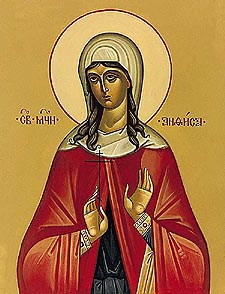Venerable Anthusa of Constantinople

The holy princess Anthusa of Constantinople was the daughter of the Iconoclast emperor Constantine Copronymos (reigned 741-775) and his third wife Eudokia. She and her twin brother, the future emperor Leo the Khazar (775-780), were born on January 25, 750.
Constantine had tortured the holy Abbess Anthusa of Mantinea (July 27) because she venerated the holy icons. During a campaign in Paphlagonia, he had her brought before him again, promising her even harsher torments if she did not come around to his way of thinking. She remained steadfast in defending the icons, however. Constantine told her that his wife was having difficulty in her pregnancy, and he asked her to pray for the empress. She agreed to do so, and told him that the children would be born safely, and even spoke about their future life.
Empress Eudokia's daughter was given the name Anthusa, in thanksgiving for the safe delivery of the twins. When Saint Anthusa's prediction was fulfilled, she was allowed to return to her convent, where she died at a ripe old age.
When she grew up, the emperor began to urge his daughter to marry. But from her youth Saint Anthusa yearned for monasticism and refused to consider his suggestions. After the death of her father, she shared her possessions with the poor, and used her wealth to adorn many churches. She became a mother to orphans, and was also a protector of widows. She devoted herself entirely to a life of piety, constantly offering prayers to the Lord and reading the Holy Scriptures. The devout empress Irene (780-802), wife of Leo the Khazar, regarded Saint Anthusa with love and esteem and invited her to be a co-regent. Saint Anthusa, however, did not desire any worldly honors. Since she lived at the palace, she wore clothes befitting her position as an emperor's daughter, but underneath her finery she wore a hair-shirt.
Desiring a life of solitary asceticism, Anthusa entered the monastery of Saint Euthymia, and received the monastic tonsure from Saint Tarasius, the Patriarch of Constantinople (Feb. 25). She founded the Omonia (Concord, or Charity) monastery at Constantinople, which was known for its strict Rule. Saint Anthusa was an example of humility to the other nuns. She did hard work, she cleaned the church, and carried water. She never sat at the table during meals, but served the sisters instead. She made sure that no one left the monastery in need.
The humble and gentle ascetic lived until the age of fifty-two, and died peacefully in 801. Other sources say she reposed in 808 when she was fifty-seven.
